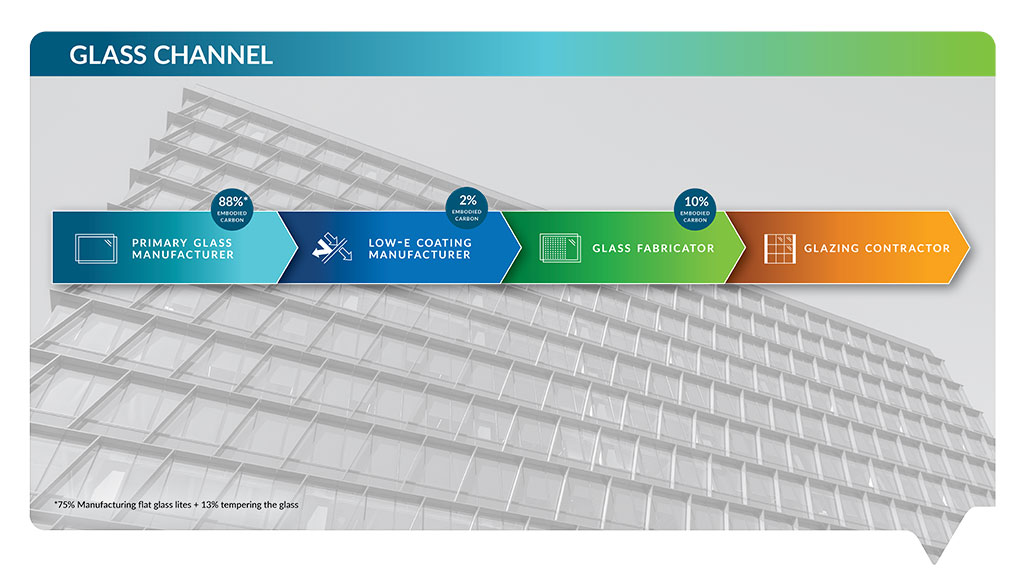The significance of reducing embodied carbon continues to grow.
Understanding Embodied Carbon
As architects and glaziers work to design and construct buildings in a more sustainable manner, the consideration of embodied carbon content in the products being used has become a significant factor in understanding the overall impact of a project’s carbon footprint.
Designers are working to reduce the overall carbon footprint of their buildings by choosing construction materials with lower embodied carbon, which refers to the carbon emissions caused by the manufacture and installation of the materials.
Sustainability advocates are working to introduce embodied carbon limits in places like California, which recently amended its CALGreen Building Standards Code to place limits on embodied carbon emissions in commercial and school buildings, and experts predict similar legislation will pass in additional states in the years to come. To understand the impact these initiatives will have on the architectural glass industry, it is important to first understand the role embodied carbon plays in glass production.

Carbon and Architectural Glass Production
An important metric to consider that relates to embodied carbon in glass (or any building product) is Global Warming Potential (GWP). This measure takes all the energy used to create a product and converts it into kilograms of equivalent carbon dioxide, expressed as the term “CO2-eq.” The purpose of calculating GWP is to help stakeholders and sustainability programs more effectively gauge the environmental performance of glass and other products manufactured for buildings.
Most of the embodied carbon in glass originates with the energy-intensive process of heating the melting furnace to 3,000 degrees Fahrenheit to convert raw materials to flat glass. The processes of adding energy-efficient low-e coatings, tempering, laminating, and fabricating flat glass into insulating glass units (IGUs) also contribute to the glass’s GWP – but to a lesser degree. (See the Glossary page for information on some of these terms.)
In fact, approximately 78% of the embodied carbon in an IGU can be credited to manufacturing flat glass lites (glass used in window products). It is estimated that of an IGU’s remaining embodied carbon, 13% comes from heat strengthening or tempering the glass, 10% comes from the IGU fabrication process itself, and just 2% comes from adding low-e coatings.

In 2019, the National Glass Association (NGA) published an architectural glass Environmental Product Declarations (EPD) that evaluated the embodied carbon of clear, low-iron, and tinted flat glass produced by four member companies of the NGA’s Forming Committee, including Vitro. Its findings suggested an industry average GWP of 1,430 kilograms for comparable architectural glass products. Vitro’s own EPDs, updated in 2023, indicate that its products contain just 1350 kilograms of CO2 equivalent, which is 6% lower than the NGA’s industry-standard figure and an improvement on figures first reported in 2017.
Reducing Embodied Carbon
To reduce embodied carbon in architectural IGUs, glass manufacturers may consider taking some of the following steps to reduce overall energy consumption in glass production:
- Improving efficiency within furnace control systems to reduce variability of melting temperatures and fuel consumption;
- Adding low-NOx burners to plants;
- Using variable frequency drives on cooling fans to reduce energy use;
- Utilizing recycled raw materials (both pre-and post-industrial) to reduce fuel consumption;
- Converting facility lighting to LED, which reduces electric consumption by as much as 80% vs. incandescent lighting and
- Using oxy-fuel technology can reduce energy consumption in glass-melting furnaces by as much as 20% and cut greenhouse gas emissions in half.
While raw glass production generates embodied carbon, high-performing low-e coated glasses are energy efficient and help reduce the negative environmental impact of embodied carbon on the built environment.
Evaluating Embodied Carbon
Environmental Product Declarations (EPDs) are third-party verified documents that provide detailed data about the life cycle impacts of building products on the environment and may be used as credentialing for LEED® and other green building certification programs.
The purpose of an EPD is to provide information on the estimated environmental impact of the product over its life cycle. In the context of evaluating embodied carbon, EPDs provide information about how a product was constructed and what steps manufacturers took to reduce energy expenditures. The breakdown of materials used to create the glass is also listed in the EPD.
For more information about EPDs for glass industry products, review the National Glass Association’s General EPD Education document on the NGA website at glass.org. To download Vitro’s Uncoated Glass and Processed Glass EPDs, visit vitroglazings.com/carbon.
About Vitro Architectural Glass
Vitro Architectural Glass, part of Vitro, S.A.B. de C.V. (BMV:VITROA), the largest company of its kind in the Americas, manufactures a range of industry-leading, energy-efficient products such as Solarban®, Sungate® and Starphire Ultra-Clear® glasses at U.S. plants in Carlisle, Pennsylvania; Fresno, California; Salem, Oregon; and Wichita Falls, Texas. Committed to sustainable manufacturing processes and products, the company also operates one of the world’s largest glass research and development facilities in Pittsburgh and four residential glass fabrication plants in Canada. Upholding the values of “Together, We See Further” across the architectural, automotive and containers markets, Vitro strives to realize the power of partnership to ensure that projects meet or exceed ever-evolving sustainability expectations as well as glass requirements. For more information, please visit www.VitroGlass.com
